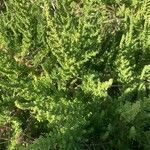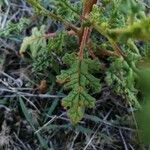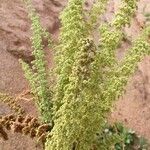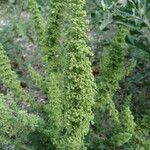Herbs annual, yellow-green, 20-50 cm tall, with a strong odor, covered with stalked, glandular hairs. Stem erect, mostly branched from base. Petiole 2-10 mm; leaf blade oblong, 2-4 × 1-2 cm, base cuneate, margin pinnately parted, apex subobtuse, sometimes mucronulate; lobes obtuse, usually obtusely toothed; upper leaves lanceolate, smaller, margin entire. Compound dichasia axillary, forming tower-shaped panicles on upper branches. Flowers bisexual. Perianth segments (4 or)5, erect in fruit, yellow-green, oblong, abaxially glandular, not longitudinally keeled or only weakly keeled, margin membranous, apex subobtuse or acuminate. Stamens 1-3. Stigmas 2, filiform. Utricle depressed globose; pericarp whitish, membranous . Seed horizontal, black, sublustrous, depressed, 0.75-1 mm in diam., almost unpitted, rim margin obtuse, slightly sulcate. Fl. Jul-Aug, fr. Aug-Sep.
An annual herb. It grows 20-50 cm tall. It is yellow green.




